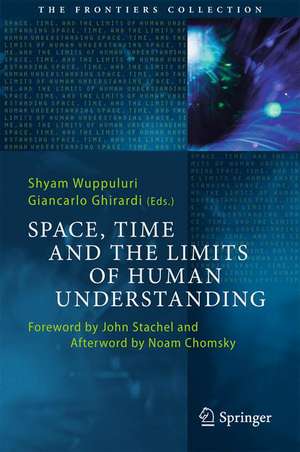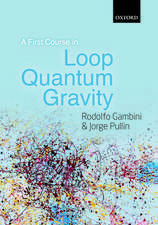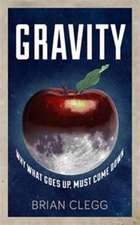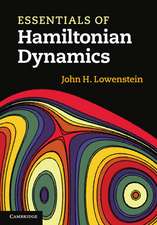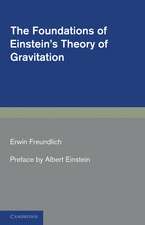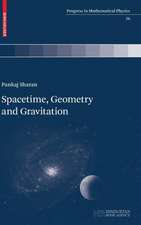Space, Time and the Limits of Human Understanding: The Frontiers Collection
Editat de Shyam Wuppuluri, Giancarlo Ghirardien Limba Engleză Hardback – 12 dec 2016
Time and again, through the prism of intellect, humans have tried to diffract reality into various distinct, yet seamless, atomic, yet holistic, independent, yet interrelated disciplines and have attempted to study it contextually. Philosophers debate the paradoxes, or engage in meditations, dialogues and reflections on the content and nature of space and time. Physicists, too, have been trying to mold space and time to fit their notions concerning micro- and macro-worlds. Mathematicians focus on the abstract aspects of space, time and measurement. While cognitive scientists ponder over the perceptual and experiential facets of our consciousness of space and time, computer scientists theoretically and practically try to optimize the space-time complexities in storing and retrieving data/information. The list is never-ending. Linguists, logicians, artists, evolutionary biologists, geographers etc., all are trying to weave a web of understanding around the same duo. However, our endeavour into a world of such endless imagination is restrained by intellectual dilemmas such as: Can humans comprehend everything? Are there any limits? Can finite thought fathom infinity?
We have sought far and wide among the best minds to furnish articles that provide an overview of the above topics. We hope that, through this journey, a symphony of patterns and tapestry of intuitions will emerge, providing the reader with insights into the questions: What is Space? What is Time?
Chapter [15] of this book is available open access under a CC BY 4.0 license.
| Toate formatele și edițiile | Preț | Express |
|---|---|---|
| Paperback (1) | 512.02 lei 6-8 săpt. | |
| Springer International Publishing – 4 iul 2018 | 512.02 lei 6-8 săpt. | |
| Hardback (1) | 518.60 lei 6-8 săpt. | |
| Springer International Publishing – 12 dec 2016 | 518.60 lei 6-8 săpt. |
Din seria The Frontiers Collection
- 20%
 Preț: 501.18 lei
Preț: 501.18 lei - 17%
 Preț: 366.23 lei
Preț: 366.23 lei - 20%
 Preț: 340.49 lei
Preț: 340.49 lei -
 Preț: 223.35 lei
Preț: 223.35 lei -
 Preț: 312.94 lei
Preț: 312.94 lei -
 Preț: 308.36 lei
Preț: 308.36 lei -
 Preț: 395.47 lei
Preț: 395.47 lei -
 Preț: 298.66 lei
Preț: 298.66 lei - 17%
 Preț: 525.36 lei
Preț: 525.36 lei -
 Preț: 215.30 lei
Preț: 215.30 lei - 17%
 Preț: 493.42 lei
Preț: 493.42 lei -
 Preț: 355.86 lei
Preț: 355.86 lei -
 Preț: 351.90 lei
Preț: 351.90 lei -
 Preț: 323.05 lei
Preț: 323.05 lei -
 Preț: 396.40 lei
Preț: 396.40 lei -
 Preț: 297.61 lei
Preț: 297.61 lei -
 Preț: 225.86 lei
Preț: 225.86 lei -
 Preț: 283.50 lei
Preț: 283.50 lei -
 Preț: 270.71 lei
Preț: 270.71 lei -
 Preț: 321.30 lei
Preț: 321.30 lei -
 Preț: 271.81 lei
Preț: 271.81 lei - 15%
 Preț: 536.96 lei
Preț: 536.96 lei - 5%
 Preț: 383.93 lei
Preț: 383.93 lei -
 Preț: 500.84 lei
Preț: 500.84 lei -
 Preț: 484.69 lei
Preț: 484.69 lei - 15%
 Preț: 590.16 lei
Preț: 590.16 lei - 15%
 Preț: 543.98 lei
Preț: 543.98 lei - 15%
 Preț: 481.34 lei
Preț: 481.34 lei - 15%
 Preț: 640.24 lei
Preț: 640.24 lei -
 Preț: 401.79 lei
Preț: 401.79 lei -
 Preț: 388.34 lei
Preț: 388.34 lei -
 Preț: 390.63 lei
Preț: 390.63 lei - 15%
 Preț: 478.05 lei
Preț: 478.05 lei - 15%
 Preț: 475.15 lei
Preț: 475.15 lei - 15%
 Preț: 534.36 lei
Preț: 534.36 lei -
 Preț: 389.49 lei
Preț: 389.49 lei -
 Preț: 493.85 lei
Preț: 493.85 lei -
 Preț: 394.29 lei
Preț: 394.29 lei -
 Preț: 459.92 lei
Preț: 459.92 lei
Preț: 518.60 lei
Preț vechi: 610.11 lei
-15% Nou
Puncte Express: 778
Preț estimativ în valută:
99.25€ • 102.53$ • 82.60£
99.25€ • 102.53$ • 82.60£
Carte tipărită la comandă
Livrare economică 25 martie-08 aprilie
Preluare comenzi: 021 569.72.76
Specificații
ISBN-13: 9783319444178
ISBN-10: 3319444174
Pagini: 450
Ilustrații: XXIII, 530 p. 51 illus.
Dimensiuni: 155 x 235 x 37 mm
Greutate: 0.95 kg
Ediția:1st ed. 2017
Editura: Springer International Publishing
Colecția Springer
Seria The Frontiers Collection
Locul publicării:Cham, Switzerland
ISBN-10: 3319444174
Pagini: 450
Ilustrații: XXIII, 530 p. 51 illus.
Dimensiuni: 155 x 235 x 37 mm
Greutate: 0.95 kg
Ediția:1st ed. 2017
Editura: Springer International Publishing
Colecția Springer
Seria The Frontiers Collection
Locul publicării:Cham, Switzerland
Cuprins
Philosophy: Śrīharṣa on the Indefinability of Time by Jonathan Duquette and Krishnamurti Ramasubramanian.- Why Spacetime Has a Life of its Own by James Robert Brown.- From Time to Time by Nathan Salmon.- Relativity Theory may not have the last Word on the Nature of Time: Quantum Theory and Probabilism by Nicholas Maxwell.- Space as a Source and as an Object of Knowledge: The Transformation of the Concept of Space in the Post-Kantian Philosophy of Geometry by Francesca Biagioli.- Space, Time and (how they) Matter by Valia Allori.- The Phenomenology of Space and Time: Husserl, Sartre, Derrida by Hans Herlof Grelland.- Time and Space in Ancient India, Pre-Philosophical Period by Michael Witzel and Nataliya Yanchevskaya.- Time in Physics and Time in Awareness by E. C. G. Sudarshan.- Physics: The Future’s Not Ours to See, by Tony Sudbury.- Nature’s Book Keeping System by Gerard ‘t Hooft.- An anomaly in space and time and the origin of dynamics by Joan A. Vaccaro.- Spacetime and Reality: Facing the Ultimate Judge by Vesselin Petkov.- Hermann Weyl’s Space-Time Geometry and its Impact on Theories of Fundamental Interactions by Norbert Straumann.- Space, Time, and Adynamical Explanation in the Relational Blockworld by W.M. Stuckey, Michael Silberstein, and Timothy McDevitt.- Matter, Space, Time, and Motion: A Unified Gravitational Perspective by C. S. Unnikrishnan.- Spacetime is Doomed by George Musser.- Mathematics: Geometry and Physical Space by Mary Leng.- The Geometry of Manifolds and the Perception of Space by Raymond O. Wells, Jr.- Topos Theoretic Approach to Space and Time by Goro C. Kato.- Paradox? The Mathematics of Space-Time and the Limits of Human Understanding by Paul Ernest.- General Relativity, Time, and Determinism by James Isenberg.- “Now” has an infinitesimal positive durationby Reuben Hersh.- The Fundamental Problem of Dynamics by Julian Barbour.- What’s wrong with the Platonic ideal of space and time? by Lorenzo Sadun.- Biology/Cognitive Science: Syntactic Space by Rajesh Kasturirangan.- Time measurement in living systems: Human understanding and health implications by L Abhilash and Vijay Kumar Sharma.- The cellular space-the space of life by Pier Luigi Luisi.- The consciousness of space, the space of consciousness by Mauro Bergonzi and Pier Luigi Luisi.- Time and Suffering (False metaphors, (de)synchronous times, and internal dynamics) by Norman Sieroka.- Evolutionary Time and the Creation of the Space of Life by Randall E. Auxier.- Computer Science: A computational mathematics view of space, time and complexity by David H. Bailey and Jonathan M. Borwein.- The Black Hole in Mathematics by A. K. Dewdney.- Gödel’s Ontological Dreams byGary Mar.- ‘Photographing the Footsteps of Time’: Space and Time in Charles Babbage’s Calculating Engines by Doron Swade.- Gödel incompleteness and the empirical sciences by N. C. A. da Costa and F. A. Doria.- Miscellaneous: The Novel and the Map: Spatiotemporal Form and Discourse in Literary Cartography by Robert T. Tally Jr.- Time, Space, and the Human Geographies of Opportunity by Donald G. Janelle.- Losing Time and Space: Experiencing Immersion by Diana J. Reichenbach.
<
<
Notă biografică
Shyam Wuppuluri is an independent researcher working in the domain of foundations of science. His research interests range from philosophy to theoretical physics, mathematics and cognitive science. He is the recipient of Honra ao Mérito from the Brazilian Academy of Philosophy (Academia Brasileira de Filosofia) and has been a corresponding member of the academy since 2018. He is also the recipient of the prestigious Albert Einstein Fellowship 2020 from the Einstein Forum at Potsdam & Caputh and is a fellow of Royal Society of Arts. He is the instigating editor of several highly interdisciplinary volumes that disseminate and discuss issues underlying the foundations of sciences, and for which he has gathered the world's leading scientists and intellectuals as contributors; among them Noam Chomsky, Sir Roger Penrose, Sir Martin Rees, Daniel Dennett, A. C. Grayling, Nicholas Humphrey, Gregory Chaitin, Gerard 't Hooft, Ian Stewart, Barry Mazur, Stephen Wolfram, Paul Davies, Tyler Burge, Doron Swade, Julian Barbour, Newton Da Costa, Francisco Antonio Doria, Reuben Hersh, Nicholas Maxwell and many others.
GianCarlo Ghirardi served as the director of Theoretical physics at University of Trieste for more than two decades. He is now the President of the Consortium for Physics of the University of Trieste and Consultant and Member of the Academic Board of the ICTP, Trieste. GianCarlo made important contributions to the foundations of quantum mechanics, particularly through the GRW interpretation, proposed jointly with Rimini and Weber. He has authored many articles and books, and organized many conferences. An intellectual leader, he is a recipient of many honors, accolades and international awards.
GianCarlo Ghirardi served as the director of Theoretical physics at University of Trieste for more than two decades. He is now the President of the Consortium for Physics of the University of Trieste and Consultant and Member of the Academic Board of the ICTP, Trieste. GianCarlo made important contributions to the foundations of quantum mechanics, particularly through the GRW interpretation, proposed jointly with Rimini and Weber. He has authored many articles and books, and organized many conferences. An intellectual leader, he is a recipient of many honors, accolades and international awards.
Textul de pe ultima copertă
In this compendium of essays, some of the world’s leading thinkers discuss their conceptions of space and time, as viewed through the lens of their own discipline. With an epilogue on the limits of human understanding, this volume hosts contributions from six or more diverse fields. It presumes only rudimentary background knowledge on the part of the reader.
Time and again, through the prism of intellect, humans have tried to diffract reality into various distinct, yet seamless, atomic, yet holistic, independent, yet interrelated disciplines and have attempted to study it contextually. Philosophers debate the paradoxes, or engage in meditations, dialogues and reflections on the content and nature of space and time. Physicists, too, have been trying to mold space and time to fit their notions concerning micro- and macro-worlds. Mathematicians focus on the abstract aspects of space, time and measurement. While cognitive scientists ponder over the perceptual and experiential facets of our consciousness of space and time, computer scientists theoretically and practically try to optimize the space-time complexities in storing and retrieving data/information. The list is never-ending. Linguists, logicians, artists, evolutionary biologists, geographers etc., all are trying to weave a web of understanding around the same duo. However, our endeavour into a world of such endless imagination is restrained by intellectual dilemmas such as: Can humans comprehend everything? Are there any limits? Can finite thought fathom infinity?
We have sought far and wide among the best minds to furnish articles that provide an overview of the above topics. We hope that, through this journey, a symphony of patterns and tapestry of intuitions will emerge, providing the reader with insights into the questions: What is Space? What is Time?
Chapter [15] of this book is available open access under a CC BY 4.0 license.
Time and again, through the prism of intellect, humans have tried to diffract reality into various distinct, yet seamless, atomic, yet holistic, independent, yet interrelated disciplines and have attempted to study it contextually. Philosophers debate the paradoxes, or engage in meditations, dialogues and reflections on the content and nature of space and time. Physicists, too, have been trying to mold space and time to fit their notions concerning micro- and macro-worlds. Mathematicians focus on the abstract aspects of space, time and measurement. While cognitive scientists ponder over the perceptual and experiential facets of our consciousness of space and time, computer scientists theoretically and practically try to optimize the space-time complexities in storing and retrieving data/information. The list is never-ending. Linguists, logicians, artists, evolutionary biologists, geographers etc., all are trying to weave a web of understanding around the same duo. However, our endeavour into a world of such endless imagination is restrained by intellectual dilemmas such as: Can humans comprehend everything? Are there any limits? Can finite thought fathom infinity?
We have sought far and wide among the best minds to furnish articles that provide an overview of the above topics. We hope that, through this journey, a symphony of patterns and tapestry of intuitions will emerge, providing the reader with insights into the questions: What is Space? What is Time?
Chapter [15] of this book is available open access under a CC BY 4.0 license.
Caracteristici
Foreword by John Stachel and Afterword by Noam Chomsky Features leading authors from across the spectrum of scholarly inquiry All authors focus on clarity so as to reach both general readers and academics Highly interdisciplinary collection facilitates a better understanding of space and time than any one perspective can provide Triggers intuition and analogies across the disciplines Essays are intentionally kept short so that the resulting "tapestry" can be appreciated as a whole Includes supplementary material: sn.pub/extras
